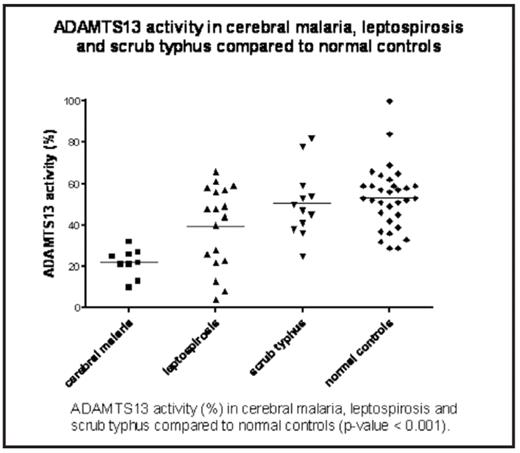Abstract
The thrombotic microangiopathy observed in severe malaria and leptospirosis shows resemblance to that of thrombotic thrombocytopenic purpura (TTP) and haemolytic uremic syndrome (HUS), respectively. The pathophysiology of these complications remains incompletely understood. TTP and (in some cases) HUS are associated with a deficiency of ADAMTS13, a metalloprotease that cleaves large prothrombotic VWF multimers. We hypothesized that ADAMTS13 may be deficient in cerebral malaria and leptospirosis, and that the severity of ADAMTS13 deficiency may be associated with the degree of endothelial activation. We investigated a series of patients with cerebral malaria (n=9) and leptospirosis (n=18). Patients with scrub typhus (n=12) representing a disease that is accompanied by endothelial activation, but without the clinical features of TTP-HUS, and healthy blood donors served as controls. Baseline characteristics did not significantly differ between study groups, except for BUN values which were higher in cerebral malaria than in leptospirosis (p-value 0.046). The Glasgow Coma Scale (GCS) score was evidently lower in cerebral malaria, with a median score of 4 (interquartile range 3–6) while subjects with leptospirosis, scrub typhus and normal controls had (near) maximum scores of 15. ADAMTS13 levels were significantly reduced in both cerebral malaria and leptospirosis, compared to scrub typhus and normal controls, with a significantly more severe deficiency in cerebral malaria than in leptospirosis (data in figure). VWF antigen and VWF propeptide levels were elevated in all three disease groups in comparison to healthy controls (p-values < 0.001), and most markedly increased in cerebral malaria. ADAMTS13 activity inversely correlated with both VWF antigen and VWF propeptide levels (p-values <0.001 and 0.005). No significant correlation was apparent between ADAMTS13 activity and hemoglobin (Hb) concentration or platelet count. Free Hb levels were not elevated in any of the patient groups, hence it seems highly unlikely that free Hb is involved in the observed reduction of ADAMTS13 activity in cerebral malaria and leptospirosis. The results of this study indicate that ADAMTS13 levels are decreased in patients with cerebral malaria and leptospirosis providing direct support to the hypothesis of a role of ADAMTS13 in the pathogenesis of the thrombotic microangiopathy associated with these diseases. Further research seems warranted to establish the role of ADAMTS13 deficiency in the development and the severity of these diseases, and to evaluate its prognostic significance. Potentially, ADAMTS13 function might serve as a risk marker of disease severity and it may be speculated that the administration of exogenous (recombinant) ADAMTS13 can be used as an adjunctive therapeutic strategy in the clinical management of patients with cerebral malaria and severe leptospirosis.
Disclosures: No relevant conflicts of interest to declare.
Author notes
Corresponding author


This feature is available to Subscribers Only
Sign In or Create an Account Close Modal